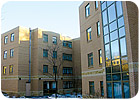
While this Fairfield University dormitory had an HVAC system that met most of the building's needs, the fact that it wasn't equipped for dehumidifica-tion presented moisture problems. First temporary dehumidification, then installation of permanent units, increased the amount of fresh air for the building, along with a controllable environment in the common areas of the building for both temperature and humidity.
Schools and universities are a prime candidate for moisture-related problems. Fresh air requirements for classrooms have changed dramatically in the past few years. Where 5 cfm of fresh air per student was once allowed and was adequately conditioned by packaged systems, today's 15 cfm of fresh air per student poses an uneconomical and almost impossible challenge for these same systems. Like classrooms, 15 cfm of fresh air per student is also required to be brought into university dormitories. This fresh air requirement generates a substantial moisture load and a potential for IAQ problems if not properly conditioned.
‘GROSS CONDENSATION PROBLEMS'
One such university facing moisture related problems was Fairfield University in Fairfield, CT. The four-story, 74,000-sq-ft Village Apartment dormitory houses 192 students and was developing mold growth due to the humid air introduced into the common air of the hallways. There are 49 four-bedroom apartments, each with 1.5 baths along with a kitchen and living room."We had a terrible problem in the dorms related to the makeup air system. The students had operable windows and the makeup air was not conditioned in the summertime. This was causing gross condensation problems on all metal surfaces that were being cooled by the air conditioner," explained Bill Romatzick, plant systems supervisor for Fairfield University.
The original five Magic Air rooftop units that were installed in 2001 when the dorm was constructed were equipped with a glycol coil for tempering the air in the wintertime for heat and some cooling in the summer, but no dehumidification.
"The problem that we were having was on severe summer days, when the introduction of humid air into the common areas of the hallways was being drawn into the apartments and causing some mold growth which was becoming a problem. In conventional HVAC, generally only cooling coils are used to control humidity. But that approach can lead to moisture problems.
"The building runs off of our central plant chilled water system and at times the dewpoint in the space would be so high, even the insulated piping would haze and get damp on the surface," Romatzick explained. Fairfield University decided to take control of their moisture issues and repair the damage at its source. Dedicated makeup air systems have quickly become recognized as the solution for effectively and efficiently conditioning outside air before it is brought into buildings.
A TRUE TRIAL RUN
After renting Munters temporary drying equipment to assist in the remediation process, the university installed Munters permanent HCU units, in the dorms, to constantly guard the facility from moisture issues. "My first contact was with Munters portable rental division, MCS, Romatzick said. "We rented four 2,500 cfm dehumidifiers for two weeks. We closed the building and dried it out," he added. After replacing damaged materials, the university's in-house design staff in conjunction with the local Carrier representative, came up with a permanent solution to the problem."We installed the Munters units in series with our existing Magic Air units and also were able to interface them with our Carrier energy management system. Using hallway and outdoor air sensors to trigger the dehumidification cycles based on humidity and dewpoints of the Munters, we were able to run them whenever the conditions are warranted," Romatzick noted.
The design has accomplished an increase in the capacity of the amount of fresh air for the building along with a controllable environment in the common areas of the building for both temperature and humidity.
"When we were contacted by the university in early August 2003," said Craig Marshall, vice president of Accuspec. "They had a tight timeline to complete this project because the students were returning to school in a few weeks and they had moisture-related problems due to their makeup air system. In teaming with Munters MCS Division, we were able to get rental units on site within a few days. This enabled the university to handle their immediate need while the permanent units were fabricated, and it gave the university the added bonus of testing the units to ensure they solved their problem before the placed their equipment order for their permanent units."
